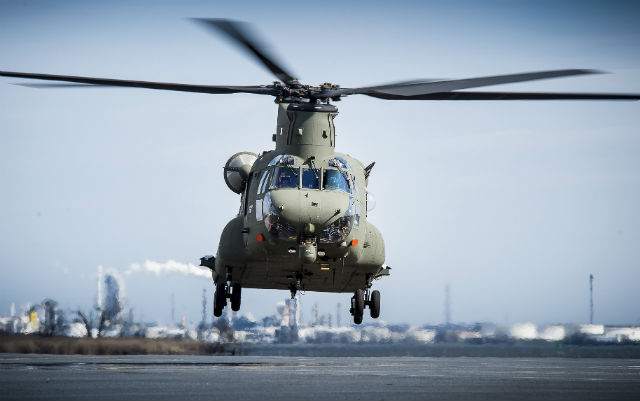The UK is exploring options for its transport rotorcraft, including in-flight refuelling, as it looks to extend the operational range of its fleet in line with commitments in a recent defence review.
Released in November, the Strategic Defence and Security Review (SDSR) promised the UK would "upgrade helicopters and transport aircraft so we can deploy further, faster and independently, to meet the threats around the world".
Speaking at the IQPC International Military Helicopter 2016 conference, Maj Gen Richard Felton, commander of the UK's multi-service Joint Helicopter Command (JHC), said several options were on the table to address that need.
With the acquisition of a new type, such as the Bell Boeing V-22 tiltrotor, unlikely, Felton says the focus is instead on adding range to existing platforms.
This could either be achieved through the installation of internal fuel tanks – with a reduced payload the trade-off – or the addition of in-flight refuelling.
However he concedes consideration will also have to be given to tankers, with the nation's only in-flight refuelling assets, the Royal Air Force's Airbus Defence & Space A330 multi-role tanker transports, which are unsuited to the slow speeds necessary for helicopter refuelling.
"We are thinking how we get an air-to-air refuelling capability. Have we got the tankers that can do it?” Felton asks. "We might go down the route of [equipping] the aircraft, but not buy the tankers because we can use another nation's."
Both the RAF's Lockheed Martin C-130J and Boeing C-17 transports can achieve the 120kt (222km/h) required, he notes, although he stresses the decision-making process is at a "really early stage".
"You can imagine we are looking at options," he says. "We want to fly further, faster and better, and we have to look at the options about what that means."
No decision has been made on any upgrade, he adds, which would be confined to "specific operations and missions" rather than a fleet-wide effort.
The SDSR also states the UK will invest in its Boeing CH-47 Chinook fleet to be able to operate it "into the 2040s".
An ongoing upgrade programme is taking older HC2 and HC3 models to the respective HC4 and HC5 standards, while the addition of digital automated flight controls further enhances capability. In addition, the RAF in late 2015 received the last new-build HC6 models, taking the fleet size to 60.
Felton says in future the UK will "try to minimise the differences between our fleets and those of other nations", particularly the USA, in acquisitions or upgrades, helping to reduce costs.
That could potentially pave the way for modifications to the UK's fleet derived from the US Army's nascent Chinook Block II initiative, designed to enable the type to stay relevant into the 2060s.

Boeing
One near-term decision, however, will be on the acquisition of 50 E-model AH-64 Apache attack helicopters to replace the British Army's Westland Boeing WAH-64 inventory.
Key to this will be to choose whether to acquire new-build examples or upgrade existing airframes.
"We are just finalising how we do that," says Felton. "We expect to reach a main-gate decision in the not too distant future." This is likely to be in "months not years", he adds.
Separately, JHC is conducting what it calls the Future Capability Study, to identify rotary-wing requirements into the 2040s and beyond.
One element of this could be to push back the retirement date of the RAF's Airbus Helicopters Puma HC2 medium transports until 2030 to bring them into line with the out-of-service date for the Royal Navy's AgustaWestland Merlin HM2s and HC4/4As.
Both types, plus the AgustaWestland AW159 Wildcat, could then be replaced with a common medium platform in 2030-40, he says.
"We have to start recognising the type of capabilities that we need and looking at what is out there."
This could be a "dual-use" aircraft – one designed for civil use and converted for military applications – as it has the potential "to be far cheaper".
JHC additionally will look to leverage the possibilities of working more closely with unmanned air vehicles in future.
This will include exploring the potential for manned-unmanned teaming between the Apache fleet and the Thales Watchkeeper WK450 UAV operated by the army.
This will be aided by the transfer of 47 regiment Royal Artillery, the unit operating the system, into JHC.
"It makes sense to give a complex air system to an air-minded community," Felton says.
Source: FlightGlobal.com



















